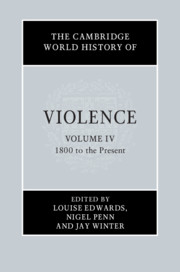Book contents
- The Cambridge World History of Violence
- The Cambridge History of Violence
- The Cambridge World History of Violence
- Copyright page
- Contents
- Figures and Maps
- Contributors to Volume IV
- Introduction to Volume IV
- Part I Race, Religion and Nationalism
- 1 Empires and Indigenous Worlds: Violence and the Pacific Ocean, 1760 to 1930s
- 2 Heresy and Banditry: Religious Violence in China since 1850
- 3 Violence, Non-Violence, the State and the Nation: India, 1858–1958
- 4 Racial Violence in the United States since the Civil War
- 5 Religion and Violence in Modern South Asia
- 6 Coercion and Violence in the Middle East
- Part II Intimate and Gendered Violence
- Part III Warfare, Colonialism and Empire in the Modern World
- Part IV The State, Revolution and Social Change
- Part V Representations and Constructions of Violence
- Index
- References
2 - Heresy and Banditry: Religious Violence in China since 1850
from Part I - Race, Religion and Nationalism
Published online by Cambridge University Press: 13 March 2020
- The Cambridge World History of Violence
- The Cambridge History of Violence
- The Cambridge World History of Violence
- Copyright page
- Contents
- Figures and Maps
- Contributors to Volume IV
- Introduction to Volume IV
- Part I Race, Religion and Nationalism
- 1 Empires and Indigenous Worlds: Violence and the Pacific Ocean, 1760 to 1930s
- 2 Heresy and Banditry: Religious Violence in China since 1850
- 3 Violence, Non-Violence, the State and the Nation: India, 1858–1958
- 4 Racial Violence in the United States since the Civil War
- 5 Religion and Violence in Modern South Asia
- 6 Coercion and Violence in the Middle East
- Part II Intimate and Gendered Violence
- Part III Warfare, Colonialism and Empire in the Modern World
- Part IV The State, Revolution and Social Change
- Part V Representations and Constructions of Violence
- Index
- References
Summary
Over its long reign, the Qing imperial state aggressively pursued unauthorized religion, both to uphold its own spiritual hegemony, and to avert religious militarization. With growing social dislocation over the nineteenth century, the dynasty faced a massive explosion of religious violence – a seemingly irrepressible series of millenarian “White Lotus” movements in central China, Muslim uprisings in the north and southwest, and the pseudo-Christian Taiping Rebellion that divided the country for more than a decade. Together, these rebellions and their suppression claimed the lives of tens of millions. The anti-Christian Boxer Uprising was brutally extirpated by a coalition of foreign forces, but at least as deadly were the waves of recriminations between Chinese villages. After coming to power in 1949, the Communist regime moved quickly to contain religion, expelling Catholic missionaries and initiating a suppression of native groups like Yiguandao. Policy towards religion appeared to soften in the 1990s, and yet remained highly vigilant towards any hint of millenarianism or religious sedition. Even knowing this, few observers were prepared for the sheer brutality of the 1999 campaign against Falungong (Dharma Wheel Practice).
- Type
- Chapter
- Information
- The Cambridge World History of Violence , pp. 41 - 67Publisher: Cambridge University PressPrint publication year: 2020

